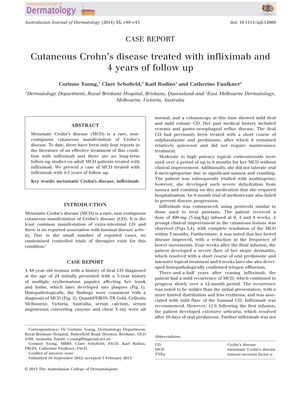Cutaneous Crohn's Disease Treated with Infliximab and 4 Years of Follow-Up
June 2013
in “
Australasian Journal of Dermatology
”

TLDR Infliximab improved skin and bowel symptoms in Crohn's disease but caused side effects and the disease returned after stopping treatment.
The document reports a case of metastatic Crohn's disease (MCD), a rare cutaneous manifestation of Crohn's disease, treated with infliximab over a period of 4.5 years. A 48-year-old woman with a history of ileal Crohn's disease presented with erythematous papules and plaques on her trunk and limbs, which were histopathologically consistent with MCD. Previous treatments, including corticosteroids, 6-mercaptopurine, azathioprine, and methotrexate, were either ineffective or not tolerated due to side effects. Infliximab treatment led to a prompt clinical improvement and complete resolution of MCD within 3 months, as well as an improvement in her bowel disease. However, the patient experienced a severe flare of atopic dermatitis and developed telogen effluvium after the treatment. Three-and-a-half years after stopping infliximab, the patient had a mild recurrence of MCD, which progressed slowly over 12 months. Upon re-treatment with infliximab, the patient developed urticaria, leading to the discontinuation of infliximab. The patient is now being considered for treatment with adalimumab. This case is significant as it is the first to report long-term follow-up of infliximab treatment in adult MCD and the first to describe MCD recurrence after initial resolution with infliximab.




